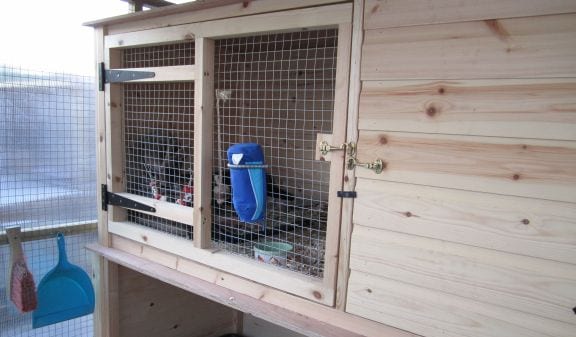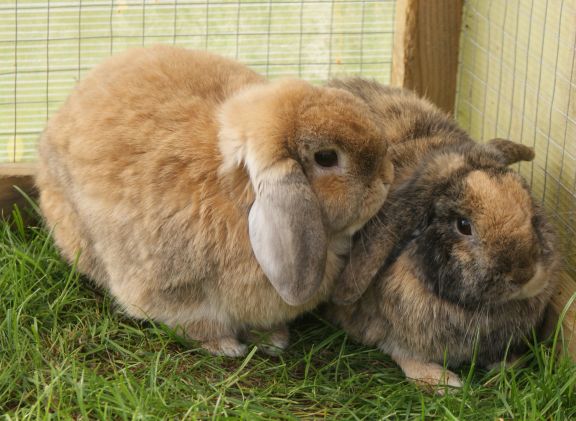Whilst pet rabbit owners may think that their pets have little in common with those in a commercial meat or fur rabbitry, it may be a surprise to know that there is a vital link – that of biosecurity. Bio-what I hear you say? Biosecurity is a system of best management practices designed to reduce the introduction and spread of infectious disease, and whether you own one little pet bunny or several pedigree show rabbits this issue is of great importance.
The three main ways that disease can be transferred to your rabbit
- Physical transference from owner or visitors via footwear, clothing, or other animals or birds. Insects such as fleas, mosquitos and other biting insects also carry several highly contagious diseases, such as myxomatosis and VHD (viral haemorrhagic disease).
- Biological transference from new, sick or contaminated rabbits via direct contact by touch or body fluids such as urine, faeces, or mucous droplets via sneezing.
- Mechanical transference from equipment (cleaning out utensils, for example) or supplies (such as bedding and food).
Knowing the factors that can allow disease to infect your rabbits is only half the battle, and it is essential to be aware of the precautions you can take to keep the risks to an absolute minimum. While developing a biosecurity programme may sound a bit over the top, the basics are relevant to anyone maintaining animals.
Basic Precautions
Isolation
Keeping a newly acquired rabbit well away from others for up to 30 days makes good sense, and you also need to be aware you can spread disease and parasites on your clothing, shoes, hands and equipment. Attending to the newcomer last, after the other inmates, does minimise this risk. If your rabbit has been to a show or boarding at a holiday centre, it is essential to do a thorough check on their return and place them well away from others for a few days as a precaution.
Observation
You must know what signs to look out for to quickly identify unusual behaviour in your rabbit so appropriate treatment or isolation can be started immediately.
Vaccination
Annual vaccination of all rabbits against myxomatosis and RVHD is essential, but remember it takes 2-3 weeks to become fully effective.
Disinfection
Keeping everything clean not only discourages insects and vermin but also prevents the accumulation of soiled bedding, which can perpetuate disease. Disinfectant sprays simplify the job, but all organic matter must be cleaned first. Perform routine spraying of litter trays, hutch floors, toys and equipment when cleaning out, remembering to thoroughly clean feeding bowls and water bottles.
Any hutches known to be contaminated require more than a routine spray – washing floors, sides, ceiling and all equipment with a strong veterinary-recommended disinfectant or diluted bleach in hot water. Leaving the hutch open to the sun afterwards is also a helpful tip. If the hutch is old and worn, it is best to dispose of it entirely and start again. Runs need to be disinfected, too, but it is almost impossible to disinfect bare ground or grass, and the only option is to move the disinfected run to a new area completely. Rabbit carriers must be disinfected, too, and a thorough spraying routinely applied after a carrier is used is a reasonable precaution, completely changing any bedding used between rabbits.
Waste disposal
Many recycling centres will allow pet owners to dispose of reasonable quantities of soiled pet bedding. However, if difficulties arise, a polite and constructive conversation with the site manager often results in a positive outcome. Trying to compost vast mounds of rotting, smelly bedding in an average garden is not viable and will undoubtedly attract flies, mice, rats, and associated diseases. Whatever method is used, correct waste disposal is essential.
Record keeping
Even with a single pet rabbit, keeping a good record of vaccination dates, age, veterinary history, and body weight is essential. Weigh the rabbit at least once a month and keep a record of it, as this will warn you of inappropriate weight gain or sudden weight loss, as sometimes this is not obvious until it is too late. Kitchen scales are helpful here!
Stress
No, I am not talking about an owner’s problems here but drawing attention to the fact that a stressed rabbit is far more prone to contracting and succumbing to illness than a non-stressed individual. Various factors, including travelling, changing environment or diet, bonding, overcrowding, and many other triggers, can cause stress. Young rabbits are more susceptible to disease caused by environmental stress than mature rabbits.
Disposal of deceased
If a rabbit dies suddenly and you have other rabbits, the body needs to be disposed of quickly and sensibly to prevent a possible spread of infection. Your vet will be able to advise on this, and if a post-mortem is to be carried out, the vet will want the body quickly as some tests cannot be carried out after some time has elapsed.
What is an Isolation Unit
If you have several rabbits, setting up an isolation area that can be used immediately makes sense. This should be a cage or hutch that is easy to disinfect thoroughly after it has been used and placed well away from other rabbits. Inside a shed is a good choice, placing the cage at a suitable working height in good light. The isolation unit needs to be equipped with its own set of cleaning utensils, disinfectant, bedding and food, and depending on the risk of infection, an extra set of footwear can be kept just inside the door, slipping out of your shoes as you go in, and reverse the procedure as you leave. Likewise, keep an overall or jacket there, too, so you can put that on when caring for the sick bunny.
If you are not going to wear disposable gloves, you must wash your hands immediately afterwards or have an anti-bacterial hand wash dispenser nearby. Visitors should not be allowed in the isolation area. If there is a concern that insects could spread the illness, use fly screening around windows and doors or over the cage to minimise the risks from mosquitos and other blood-sucking insects and make sure cats, dogs, and vermin cannot get in either. Having established reasonable procedures for preventing disease from entering your home and infecting your rabbits, let’s look at some practicalities of dealing with a sick bunny.
If your vet thinks the illness is non-contagious, there is no need to isolate it, as this will not be helpful unless doing so facilitates easier treatment. The stress involved in moving a rabbit or taking it away from bonded others is significant and may hinder recovery and predispose susceptibility to other illnesses. However, if the disease is thought to be contagious (can pass from one rabbit to another via methods described above), the following situations need to be considered:
Single rabbit – If the rabbit is on its own and there are no other rabbits in the vicinity, isolation is not an issue and treatment as appropriate can be given whilst in its usual environment.
Single rabbit with other rabbits in the vicinity – in such a situation, removing the sick rabbit from the area and placing it in isolation well away from others is essential.
One of a pair – the chances are high that once you know one of the rabbits is ill, the other one is likely to be already infected too, in which case isolating the sick bunny will not achieve anything except to stress both of them unnecessarily. If one needs specialist vet treatment, such as inserting a catheter for a drip, it is obvious the bonded partner will not be able to stay. Still, they should be reunited as soon as it is possible and safe to do so to keep the bonding strong and give comfort to the ill rabbit.
One of a group – keeping a small group together, if practical, to do so is the best way forward. Removing the sick rabbit will cause stress to all of them and will change the dynamics of the group, which would likely lead to fighting and possibly the non-acceptance of the sick rabbit if they try to reintroduce it later on. If the group is large, it may be best to isolate the affected individual, but the rest may also be infected by this stage. If the individual is one of a group and there are other rabbits also in the vicinity, isolation of the entire group would be the recommended course of action.
One of a litter – the implications depend on whether the babies are still living with mum or are fully weaned and how many of the litter are affected. If more than one baby is showing symptoms, it is essential to isolate the whole litter (and mum if she is still feeding them) and start appropriate treatment. If it is just one baby, it may be best to take that one away into isolation and continue to monitor the others. Digestive upset in babies up to the age of 16 weeks is often due to changes in diet or inadequate diet. Although in itself, this may not be contagious, conditions like mucoid enteritis do appear to have an infectious element, often sweeping through entire litters with drastic results. Moving the whole litter into isolation if other rabbits are nearby is vital in such a situation. On no account should litters ever be mixed as this is almost guaranteed to trigger serious digestive upsets and significant losses.
Basic Rules
Keeping rabbits should be enjoyable and rewarding. For it to be so, the owner must take the necessary steps to prevent disease from arriving in the first place, know how to deal with it quickly and effectively and be aware of any long-term action that needs to be taken to ensure it does not happen again. Many illnesses in rabbits are not contagious and can occur spontaneously, but following basic rules to give your rabbit the best possible chance of a healthy and happy life makes sense. This includes:
- Making Ensure you provide suitable, safe accommodation with exercise areas appropriate for breed, numbers and age. Physical barriers between adjacent rabbits are essential to prevent urine leakage, droppings, and bedding between pens.
- Following an annual vaccination programme, together with regular observations and examinations.
- Keeping stress factors to a minimum.
- Providing the correct diet as appropriate to size, age and condition, with minimum dried food (average one egg cup per rabbit per day), provision of fresh green vegetables and grass and copious amounts of good quality meadow hay ad lib. Hay should make up 70-80% of their total diet.
- Avoid overcrowding and never mix litters, even for a short time.
- Ensure you have a good relationship with your vet to have essential medications on the shelf to treat conditions such as digestive upsets, gut stasis and other problems.
Being observant, proactive and diligent will ensure you do your best for your long-eared companions. You know they are worth it!





